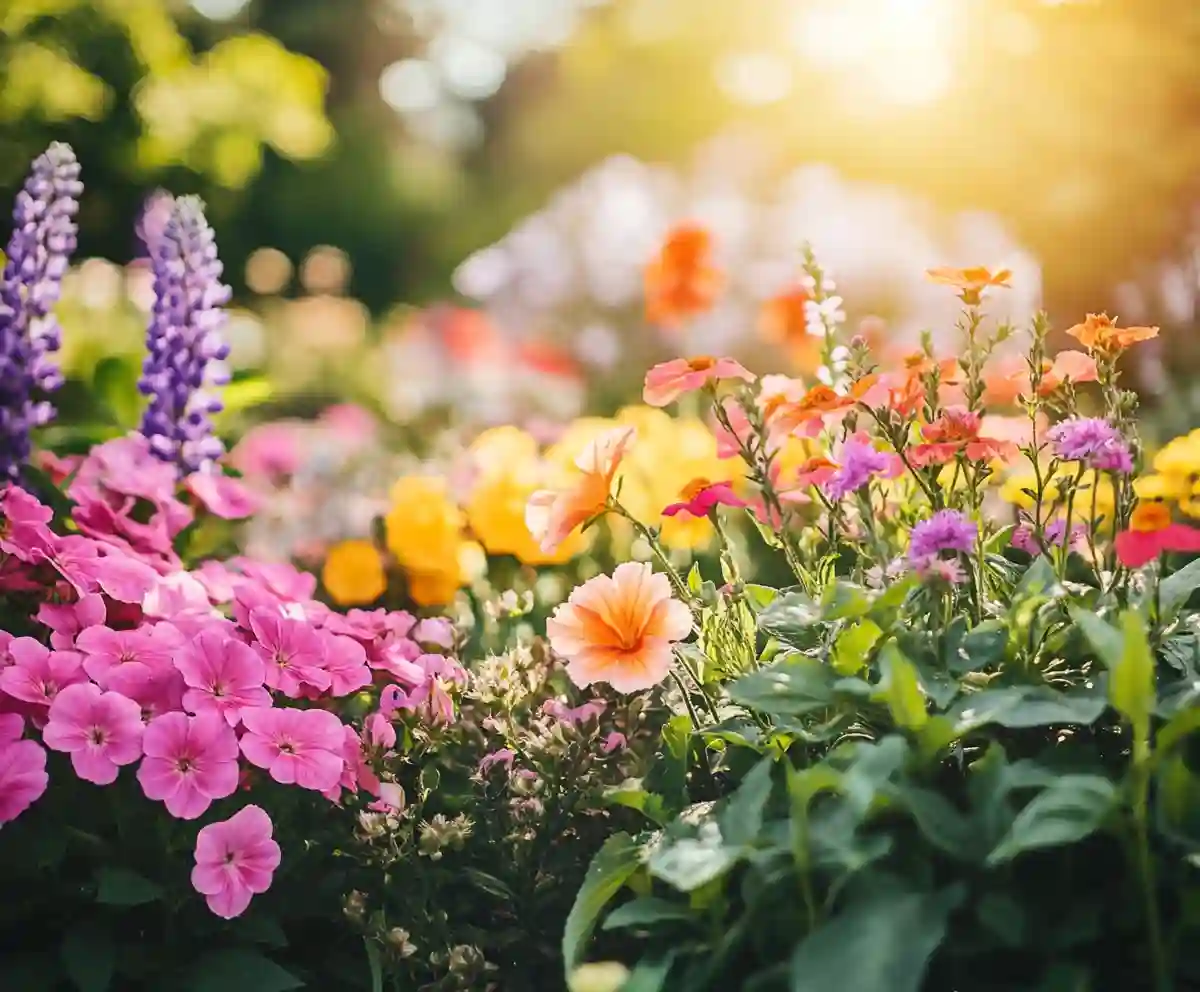Dreaming of a vibrant garden that doesn’t fizzle out after just a few weeks? If you’ve ever struggled to keep your flower beds blooming throughout the season, you’re not alone. The good news? Mastering the art of year-round color isn’t as complicated as it seems. With a thoughtful approach to plant selection and design, creating a low-maintenance, ever-blooming garden is absolutely within reach.
In this guide, you’ll learn expert tips on how to design perennial gardens that don’t just survive—but shine—from spring through winter. Whether you’re new to gardening or looking to level up your flower beds, here’s your step-by-step path to making perennials easy and rewarding.
The Mistake in Perennial Gardening (And How to Avoid It)
One of the most common missteps gardeners make is falling into what we like to call “flower fixation.” It’s easy to be dazzled by a garden center bursting with blooms—but choosing perennials based on their flowers alone can lead to a garden that only looks great for a couple of weeks.
Here’s why this happens:
- Nurseries usually stock perennials when they’re in full bloom, prompting impulse buys.
- Many gardeners overlook bloom times, resulting in beds that flower all at once—then go green and quiet for the rest of the year.
- Relying only on floral display limits seasonal interest.
Pro Tip:
Start focusing on foliage first. Leaf shape, texture, and color can carry your garden visually when flowers aren’t blooming. Many perennials have striking foliage in purples, silvers, variegated tones, and rich greens that add depth and contrast to your beds.
How to Build a Stunning Perennial Garden from the Ground Up
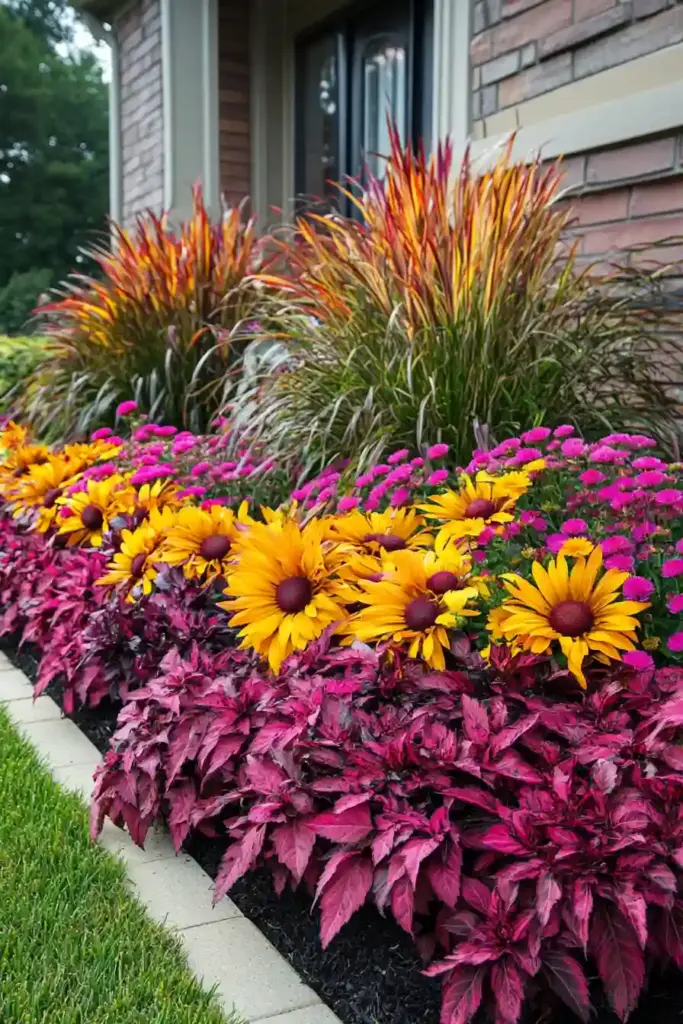
Creating a show-stopping perennial garden doesn’t require endless effort—it just needs smart planning. The secret? Design your beds with a balance of foliage, bloom timing, height, and texture. Here’s how to get started:
1. Prioritize Foliage for Year-Round Impact
Yes, flowers are the stars—but foliage is the reliable cast that keeps your garden looking great, even between blooming cycles. Look for plants with:
- Unique colors like burgundy, chartreuse, or silver
- Variegated leaves that add texture and visual contrast
- Bold shapes that create dimension (think hostas, ferns, or ornamental grasses)
💡 Design Tip: Avoid clustering plants with similar leaf colors. Instead, aim to mix textures and tones for dynamic contrast across your beds.
2. Think in Layers, Not Lines
When arranging your plants:
- Back row: Taller structural perennials like delphinium, Joe-Pye weed, or hollyhocks
- Middle layer: Mid-height bloomers like coneflowers, phlox, or daylilies
- Front edge: Low growers and fillers like creeping thyme, sedum, or coral bells
This layered approach adds depth and keeps every part of your garden visually interesting—front to back.
3. Choose Perennials With Staggered Bloom Times
Instead of planting everything that blooms in June, mix it up! Choose perennials that flower in:
- Early spring (like bleeding heart or lungwort)
- Mid-summer (think black-eyed Susan, bee balm)
- Late fall (such as Japanese anemone or sedum)
🌼 Pro Move: Read plant tags carefully to note bloom times, and plan with a calendar to ensure something is always popping.
Tips for Creating an Ever-Blooming Perennial Garden
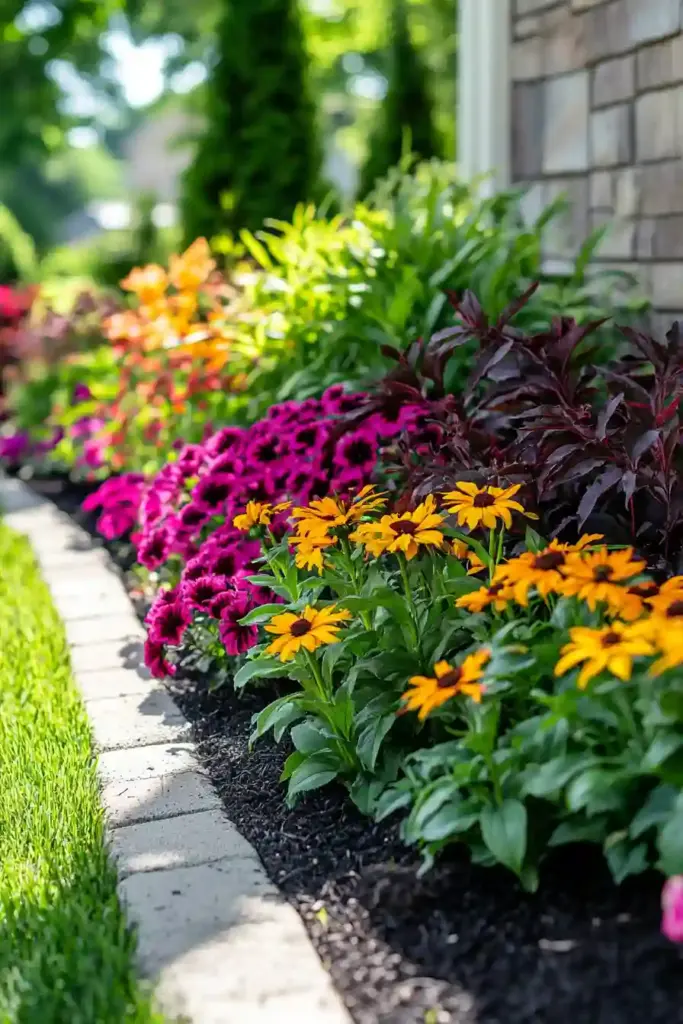
A truly vibrant garden isn’t just about what’s blooming now—it’s about what’s coming next. The key to long-lasting color is strategic staggering: layering perennials by their bloom times and mixing in foliage that holds visual interest when flowers fade.
Here’s how to do it:
1. Map Out Bloom Times
When choosing plants, don’t just look at the blooms—study the timing.
- Early bloomers: Crocus, daffodils, bleeding heart
- Mid-season: Peonies, bee balm, coneflowers
- Late bloomers: Sedum, Russian sage, Japanese anemone
🗓️ Planning Tip: Use a seasonal planting calendar or spreadsheet to keep bloom times organized. Aim to have at least one plant blooming in each season.
2. Mix It Up in Every Bed
Rather than creating “zones” of color, intermix perennials with different bloom times within the same area. This ensures your beds never go bare and keeps the garden looking fresh from April through October.
🌿 Example:
Pair early iris with mid-summer phlox and fall-blooming aster—that one spot will stay lively for months.
3. Use Color Theory to Your Advantage
In addition to bloom time, think about color harmony:
- Use contrasts like orange and purple for bold impact
- Blend analogs like pinks and reds for a softer, romantic look
- Balance bright blooms with neutral foliage for rest and rhythm
🎨 Design Insight: A fiery orange lily can pop brilliantly against the cool silver of lamb’s ear or the deep purple of ajuga foliage.
Designing Four-Season Perennial Gardens
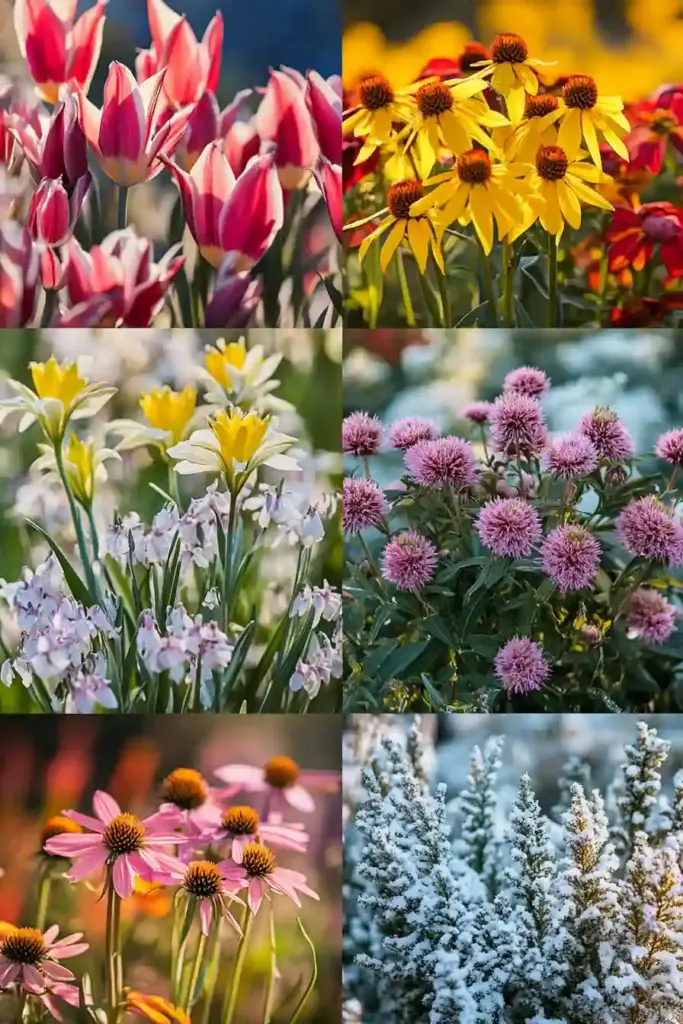
Most gardens peak in summer and then fade fast—but it doesn’t have to be that way. With a little planning, you can create a landscape that evolves gracefully with the seasons. The trick? Choose perennials and companion plants that shine in spring, summer, fall, and even winter.
Here’s how to build a four-season display:
🌸 Spring
After a long winter, early bloomers are a welcome sight.
- Top picks: Crocus, daffodils, tulips, bleeding heart, lungwort
- Bonus plants: Creeping phlox and ajuga create colorful groundcover
- Foliage favorites: Sedum and coral bells start to show off early
💡 Quick Tip: Include bulbs for pops of color before most perennials wake up.
☀️ Summer
This is when your garden usually hits full stride—so build around it carefully.
- Reliable bloomers: Coneflowers, daylilies, bee balm, black-eyed Susan, phlox
- Textural stars: Ornamental grasses and hostas add lush volume
- Pollinator favorites: Butterfly weed, yarrow, lavender
🐝 Wildlife Bonus: Summer perennials attract bees, butterflies, and hummingbirds in droves.
🍂 Fall
Don’t let your garden taper off. Use fall-blooming plants to keep things vibrant.
- Standouts: Sedum ‘Autumn Joy,’ Russian sage, mums, turtlehead, Japanese anemone
- Foliage wow-factor: Golden hosta leaves and colorful fern fronds
- Structure: Seed heads and dried flowers add elegance
🍁 Pro Tip: Trim early bloomers to give fall stars more space to shine.
❄️ Winter
Even after snowfall, your garden can still impress.
- Leave tall perennials: Coneflowers, sedum, rudbeckia, and hydrangea dry beautifully
- Texture: Ornamental grasses sway and catch snow
- Wildlife perks: Seed heads provide food for birds
Best Perennials for Every Season
A truly evergreen (well, figuratively) garden needs reliable performers that take turns showing off. Here’s a breakdown of go-to perennials to anchor your design in each season.
🌱 Early Spring Bloomers
These are your first bursts of color—perfect for chasing away the winter blues.
- Bulbs: Tulips, daffodils, crocus, hyacinths
- Shade lovers: Bleeding heart, lungwort, brunnera
- Low-growing fillers: Creeping phlox, ajuga
- Colorful foliage: Heuchera (coral bells), sedum starts popping early
🌼 Pro Tip: Plant bulbs in groups for a bolder impact, and layer different types to extend bloom time.
🌸 Late Spring to Early Summer Favorites
By this point, your garden is starting to feel lush—bring on the drama!
- Blooms: Peonies, irises, lupine, poppies, hardy geraniums
- Shrubs: Spirea, weigela, honeysuckle
- Foliage plants: Hostas, astilbe, and lungwort are stealing the spotlight
🎨 Design Tip: Use contrasting leaf shapes and bloom colors to create dynamic visual rhythm.
☀️ Mid to Late Summer Show-Stoppers
This is the garden’s moment in the sun—keep it fresh and colorful.
- Heavy bloomers: Coneflowers, black-eyed Susan, phlox, bee balm, rudbeckia
- Heat lovers: Liatris, sage, coreopsis, hardy hibiscus
- Pollinator magnets: Butterfly weed, lavender, yarrow
🦋 Wildlife Watch: These plants will turn your garden into a pollinator paradise!
🍂 Fall & Late Season Color
Just when most gardens start to fade, yours will be warming up.
- Late bloomers: Sedum, Japanese anemone, turtlehead, hardy asters, mums
- Graceful grasses: Switchgrass, little bluestem, fountain grass
- Foliage flair: Fall-toned hostas, golden ferns, and ornamental kale
🍁 Bonus: Many late bloomers pair beautifully with autumn foliage for a full fall display.
❄️ Winter Interest Perennials
Even in dormancy, your garden can stay beautiful.
- Architectural elements: Coneflower and black-eyed Susan seed heads
- Frost catchers: Russian sage and ornamental grasses
- Wildlife helpers: Hydrangea, sedum, and echinacea feed birds and offer structure
🌨️ Pro Tip: Skip heavy pruning in fall—leave perennials standing to give winter texture and wildlife benefits.
Low-Maintenance Tips to Keep Perennials Easy & Beautiful
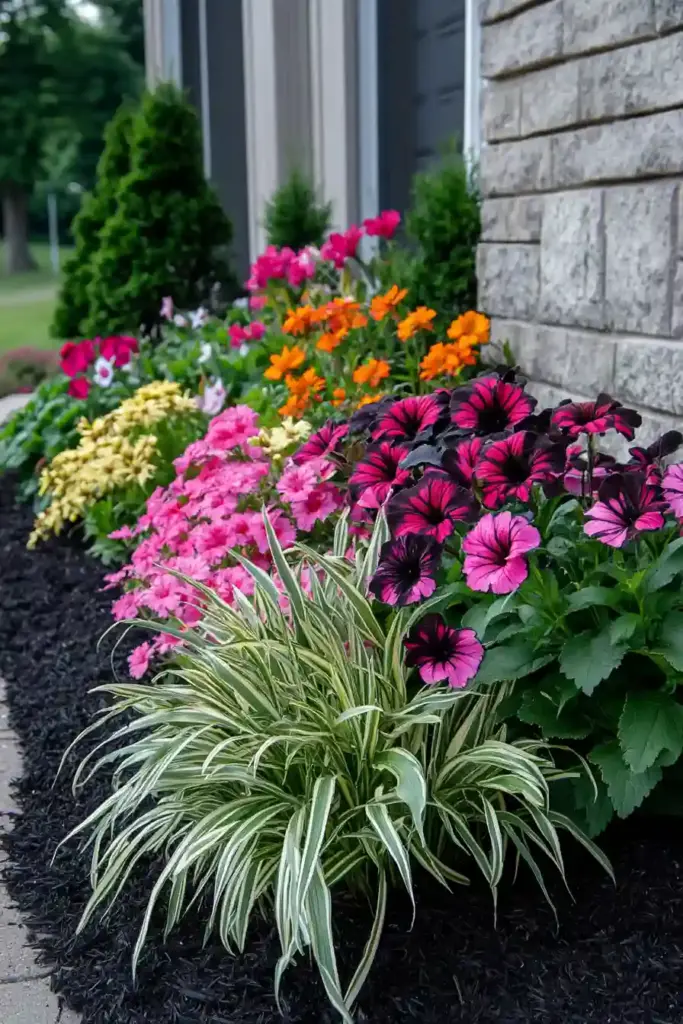
Designing a perennial garden is only half the story—maintenance is where the magic continues. But don’t worry, this doesn’t mean hours of backbreaking labor. With a few smart habits and tools, keeping your flower beds in peak shape is simple.
Here’s how to make perennials easy to care for:
🧹 Mulch for Color and Weed Control
A fresh layer of mulch does more than look tidy:
- Suppresses weeds (less pulling, more relaxing)
- Retains moisture so you water less
- Boosts color contrast between plants and soil
🌱 Best choice: Natural hardwood mulch slowly breaks down and nourishes the soil.
✂️ Prune Regularly for Shape and Bloom Boosts
Deadheading (removing spent flowers) and occasional trimming:
- Keeps plants bushy and compact
- Encourages more flowers
- Prevents legginess or flopping
🛠️ Tool tip: Invest in a pair of quality hand pruners and prune monthly during the growing season.
💧 Feed Perennials During Active Growth
To keep blooming strong, perennials need energy:
- Use a balanced slow-release fertilizer in early spring
- Supplement with liquid feeds during peak blooming months
🌼 Note: Avoid over-fertilizing—too much nitrogen can lead to foliage-heavy plants with fewer flowers.
🌿 Stake Tall or Top-Heavy Plants
Some perennials, like peonies or delphiniums, need a little support:
- Use bamboo stakes, decorative supports, or tomato cages
- Install before plants get too large to avoid damage
🪴 Pro tip: Grouping tall plants near shrubs or fences can offer natural support.
🧤 Weed Smart, Not Hard
Don’t wait until weeds take over. Tackle them while they’re small using:
- A Hori Hori knife (for slicing and digging roots)
- A Cobrahead weeder (great for tight spots)
These tools make weeding faster, easier, and more satisfying—yes, really.
Conclusion: Build a Garden You Love—All Year Long
Creating a vibrant, low-maintenance landscape doesn’t have to be overwhelming. With a little upfront planning and the right plant combinations, perennials made easy can become your gardening reality.
Focus on foliage just as much as flowers. Mix bloom times for nonstop color. And don’t forget to maintain your beds with simple, consistent care. Whether you’re a beginner or seasoned green thumb, these tips will help you grow a garden that evolves beautifully through every season—and brings joy month after month.
Now grab your gloves, sketch a plan, and start building your own ever-blooming oasis. You’ve got this!

